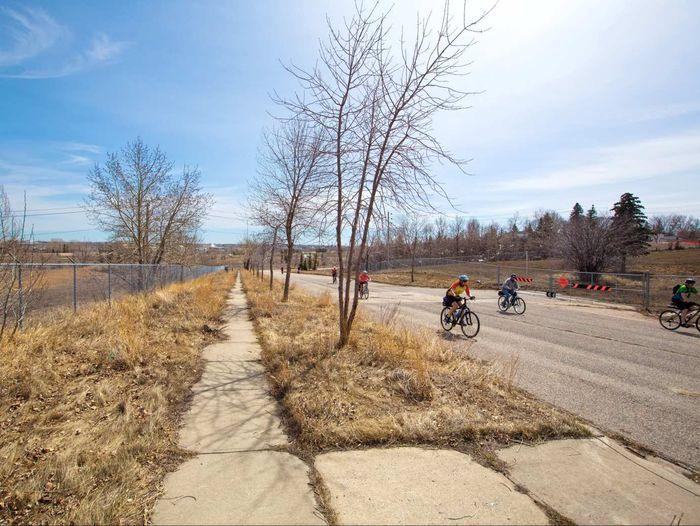
Closed signs mark the old Imperial Oil refinery site and Refinery Park on Tuesday April 25, 2018. The area, closed for years due to contamination is set to re-open as a public park this summer. Gavin Young/Postmedia
Nearly 20 years after residents of a southeast Calgary community were evacuated from their homes, contaminated lands that once housed an oil refinery are on track to be resurrected as a public park this fall.
It’s been a long, painful road for the area that between the early 1980s and 2001 housed a community of more than 200 homes and condos, before the discovery of toxic hydrocarbons were discovered in the soil, forcing most residents to leave forever.
But 17 years after the community was largely abandoned, it’s set to rebound later this year following a $31-million effort to remediate the 32-hectare site, which stretches between Beaverdam Flats and Deerfoot Trail under the Calf Robe Bridge.
Gian-Carlo Carra, the local councillor, said the area now dubbed “Refinery Park” offers an amazing opportunity to create an inner city park from the ground up.
“What we have basically is a blank slate right now. The major thrust has been to get it safe for human use,” he said.
“What we have now is a canvas to work with that we feel safe walking on and it’s an exciting time.”
According to the city, a long-shuttered bike path through the area will reopen next month while the park itself is slated to reopen in October, giving a few more months for the area’s new vegetation to establish itself.
Trent Parks, the city’s leader for environmental risk and liability, said among the balsam poplars and trembling aspen that will dot the park, groundwater pumping wells will remain in service, moving subsurface hydrocarbons to a water treatment facility on nearby 50th Avenue S.E. before returning clean groundwater to the land.

A city map of the area showing trail closures
“Things like hydrocarbons are remediated naturally over time, so we’re speeding that process up,” said Parks, noting due to the nature of the subsurface contamination there will almost always be some ongoing work at the site, long after it officially opens as parkland.
However, despite the site being deemed unfit for human habitation, Parks said there will be no risk to the public who use the reclaimed natural space.
“We’ve done a ton of work on human health risk assessments,” he said. “It’s designed to be protective of human health and it’s all been reviewed and approved by Alberta Environment.”

Cyclists take advantage of a closed section of Lynnview Road S.E. in Lynnview Ridge at the edge of the fenced off area of the old Imperial Oil refinery site on Tuesday April 25, 2018. The area, closed for years due to contamination, is set to re-open as a public park this summer. Gavin Young/Postmedia
Prior to becoming a residential community, the land housed an Imperial Oil refinery from 1926 to 1976, at the time the nation’s most modern facility. At its peak, it produced 2,500 to 3,000 barrels of gas per day and its storage tanks, where future homes would one day sit, could hold 80,000 barrels.
It was decommissioned in 1977 and just one year later the city approved a housing development on the site.
By 1985, early hints of soil contamination were found with oil oozing from the ground in Beaverdam Flats Park. It wasn’t until 2001 that environmental testing found unacceptably high levels of lead contamination in the soil in Lynnview Ridge.
Months after that discovery, 135 homes were bought out by Imperial, and ultimately only 11 homeowners from the community refused to accept buyouts.
After years of legal wrangling, Imperial ultimately cleaned the ridge area in 2009 and entered into a cost-sharing agreement with the city that saw the company pick up 60 per cent of the costs for remediating the rest of the land. Parks added Alberta Environment also chipped in with $2 million to build a subsurface barrier to prevent pollutants from leaching into the Bow River.
While the city’s parks department is still in the planning stages for the future green space, it’s expected to house a mixture of trees, shrubs and grassland that are being planted in an effort to further spur the land’s remediation. The area will also include a section of uneven ground, made up partly of covered rubble, called the “moguls.”

Closed signs mark the old Imperial Oil refinery site and Refinery Park on Tuesday, April 25, 2018. Gavin Young/Postmedia
In a statement, Calgary parks said they’re still trying to determine what will fit best into the area, a process that’s in its early stages.
“The analysis taking place through this year on the … site is a feasibility study led by parks (department) to understand what we can turn that space into, giving us the information we need to know to decide what kind of parks infrastructure would work in that space,” the statement said.
“We only just started the feasibility work and have zero details on what we think we can put in there.”
Carra said high-level plans call for four separate sections in the proposed park: a neighbourhood park area at the top of the once heavily contaminated ridge; an extension of the nearby Pop Davies Athletic Park; a river pathway system; and the majority of the site will be left as a “regional park of some kind.”
slogan@postmedia.com